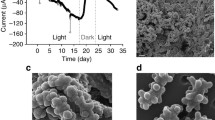Abstract
The purple sulfur bacterium Thiocapsa roseopersicina, being the dominant anoxygenic phototroph in microbial mats, was tested for growth on polysulfide as the electron donor for carbon dioxide fixation. Data collected in continuous cultures revealed μmax to be 0.065 h-1 and the saturation affinity constant K s to be 6.7 μM. The value of the inhibition constant K i was estimated in batch cultures and was found to be approximately 1100 μM. When grown on monosulfide, the organism was capable of trisulfide utilization without lag. Monosulfide-limited growth was established to have a μmax of 0.091 h-1 and K s of 8.0 μM. Field observations revealed polysulfide, present at supra-optimal concentrations, as a major pool of reduced sulfur in a laminated marine sediment ecosystem.
Similar content being viewed by others
Abbreviations
- DLP:
-
Direct Linear Plot
- TS:
-
Total Sugar
- SS:
-
Structural Sugar
- P :
-
Protein
- R R :
-
concentration of growth limiting nutrient in reservoir vessel
- S nutrient :
-
residual concentration of growth-limiting nutrient in the culture vessel
- S sulfur compound :
-
concentration of sulfur in the corresponding compound
- D :
-
dilution rate
- μmax :
-
maximum specific growth rate
- K s :
-
saturation constant
- K i :
-
inhibition constant
References
Aizenshtat Z, Stoler A, Cohen Y, Nielsen H (1983) The geochemical sulphur enrichment of recent organic matter by polysulfides in the Solar-Lake. In: Bjoroy M, Albrecht P, Cornford C, De Groot K, Eglinton G, Galimov E, Leythaeuser D, Pelet R, Rullkotter J, Speers G (eds) Advances in organic geochemistry 1981 Wiley, Chicester, pp 279–288
Andrews JF (1968) A mathematical model for the continuous culture of microorganisms utilizing inhibitory substrates. Biotechnol Bioeng 10: 707–723
Beeftink HH, Van Gemerden H (1979) Actual and potential rates of substrate oxidation and product formation in continuous cultures of Chromatium vinosum. Arch Microbiol 121: 161–167
Belkin S, Jannasch HW (1985) Biological and abiological sulfur reduction at high temperatures. Appl Environ Microbiol 49: 1057–1061
Bertolacini RJ, BarneyII JE (1957) Colorimetric determination of sulfate with barium chloranilate. Anal Chem 29:281–283
De Wit R, Van Gemerden H (1987) Chemolithotrophic growth of the phototrophic sulfur bacterium Thiocapsa roseopersicina. FEMS Microbiol Ecol 45:117–126
De Wit R, Jonkers HM, Van den Ende FP, Van Gemerden H (1989) In situ fluctuations of oxygen and sulphide in marine microbial sediment ecosystems. Neth J Sea Res 23:271–281
De Wit R, Van Gemerden H (1990) Growth of the phototrophic sulfur bacterium Thiocapsa roseopersicina under oxic/anoxic regimens in the light. FEMS Microbiol Ecol 73:69–76
Eisenthal R, Cornish-Bowden A (1974) The direct linear plot. A new graphical procedure for estimating enzyme kinetic parameters. Biochem J 139:715–720
Fairbairn NJ (1953) A modified anthrone reagent. Chem Ind 1953:86
Feher F, Laue W (1956) Beiträge zur Chemie des Schwefels. XXIX. Über die Darstellung von Rohsulfanen. Z Anorg Allg Chem 288:103–112
Kondratieva EN, Zhukov VG, Ivankovsky RN, Petushkova YuP, Monosov EZ (1976) The capacity of the phototrophic sulfur bacterium Thiocapsa roseopersicina for chemosynthesis. Arch Microbiol 146:362–369
Law JH, Slepecky RW (1961) Assay of poly-β-hydroxybutyric acid. J Bacteriol 82:33–36
Lowry OH, Rosebrough NJ, Farr AL, Randall RJ (1951) Protein measurements with the Folin phenol reagent. J Biol Chem 193:265–275
LutherIII GW, Church TM (1988) Seasonal cycling of sulfur and iron in porewaters of a Delaware salt marsh. Mar Chem 23:295–309
Mas J, Van Gemerden H (1987) Influence of sulfur accumulation and composition of sulfur globule on cell volume and buoyant density of Chromatium vinosum. Arch Microbiol 146:362–369
Monod J (1942) Recherches sur la croissance des cultures bactériennes. Hermann, Paris
Orion Inc (1979) Sulfide ion electrode, silver ion electrode model 96-16 Instruction Manual, Cambridge, Mass
Schedel M (1978) Untersuchungen zur anaeroben Oxidation reduzierter Schwefelverbindungen durch Thiobacillus denitrificans, Chromatium vinosum und Chlorobium limicola. PhD thesis, Universität Bonn, FRG
Stal LJ, Van Gemerden H, Krumbein WE (1984) The simultaneous assay of chlorophyll and bacteriochlorophyll in natural microbial communities. J Microbiol Methods 2:295–306
Stal LJ, Van Gemerden H, Krumbein WE (1985) Structure and development of a benthic marine microbial mat. FEMS Microbiol Ecol 31:111–125
Steudel R, Holdt G, Visscher PT, Van Gemerden H (1990) Search for polythionates in cultures of Chromatium vinosum after sulfide incubation. Arch Microbiol 153:432–437
Then J (1984) Beiträge zur Sulfidoxidation durch Ectothiorhodospira abdelmalekii und Ectothiorhodospira halochloris. PhD thesis Universität Bonn, FRG
Then J, Trüper HG (1983) Sulfide oxidation in Ectothiorhodospira abdelmalekii. Evidence for the catalytic role of cytochrome c-551. Arch Microbiol 135:254–258
Trüper HG, Schlegel HG (1964) Sulphur metabolism in Thiorhodaceae. I. Quantitative measurements on growing cells of Chromatium okenii. Antonie van Leeuwenhoek; J Microbiol Serol 30:225–238
Van Gemerden H (1984) The sulfide affinity of phototrophic bacteria in relation to the location of elemental sulfur. Arch Microbiol 139:289–294
Van Gemerden H, Beeftink HH (1978) Specific rates of substrate oxidation and product formation in autotrophically growing Chromatium vinosum cultures. Arch Microbiol 119:135–143
Van Gemerden H, Tughan CS, De Wit R, Herbert RA (1989) Laminated microbial ecosystems on sheltered beaches in Scapa Flow, Orkney Islands. FEMS Microbiol Ecol 62:87–102
Visscher PT, Van Gemerden H (1988) Growth of Chlorobium limicola f. thiosulfatophilum on polysulfides. In: Olsen JM, Ormerod JG, Amesz J, Stackebrandt E, Trüper HG (eds) Green photosynthetic bacteria. Plenum Press, New York, pp 287–294
Widdel F, Pfennig N (1981) Studies on dissimilatory sulfate-reducing bacteria that decompose fatty acids. I. Isolation of new sulfate-reducing bacteria enriched with acetate from saline environments. Arch Microbiol 129:395–400
Author information
Authors and Affiliations
Additional information
Dedicated to Prof. Dr. Norbert Pfennig on the occasion of his 65th birthday
Rights and permissions
About this article
Cite this article
Visscher, P.T., Nijburg, J.W. & van Gemerden, H. Polysulfide utilization by Thiocapsa roseopersicina . Arch. Microbiol. 155, 75–81 (1990). https://doi.org/10.1007/BF00291278
Received:
Accepted:
Issue Date:
DOI: https://doi.org/10.1007/BF00291278




